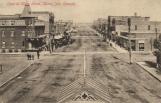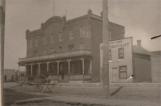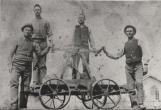1
In North America, the 19th century was the era of the gold rush, giving rise to the name Gold Mountain (Gum San). When prospects declined, there was the promise of employment as part of the railroad construction.3
For the Chinese people who began coming to Canada more than 150 years ago, crossing the Pacific was just the beginning. Drawn first by the possibility of gold in the west coast mountains and then by the promise of jobs on rail construction across Canada, the Chinese arrived in great numbers on what would become British Columbia's shore in search of the perennial dream – a better life. Conditions and competition were harsh, however, and many Chinese made the decision to continue moving eastward in search of more opportunity.5
Moose Jaw as a site was first established in 1882 by a team led by James H. Ross. The geographic position was a natural choice, as it encompassed all the ideal factors in a railway divisional point for the Canadian Pacific Railway, which was being built from Eastern Canada to the Western coast. Almost exactly mid-way between Calgary and Winnipeg, this was also the shallowest point to cross the Moose Jaw River and was an incredibly scenic location in the Wakamow Valley.7
The completion of the railroad meant that travel between the two coastlines was easier and many Chinese took advantage of this to spread out across the country in search of other opportunities. The men who arrived in Moose Jaw at the turn of the century found the seeds of a town that were soon to grow. Moose Jaw's population increased rapidly, reaching a plateau of approximately 30,000 just before the Great Depression. For the most part, the Chinese population fluctuated around 300, rising as high as 600 after the Second World War. Most men set up shop on River Street because of its proximity to the rail yards, which ensured steady business with many travellers passing through.8
Main Street looking north from the Canadian Pacific Railway Station1910
Main Street, Moose Jaw, Saskatchewan

9
Almost overnight, Moose Jaw became a boomtown. The influx of settlers brought by the new Canadian Pacific Railway led to a rapid increase in the population and a parallel demand for goods and services.10
The Brunswick Hotel and Quong Sing Restaurant on River Street1910
River Street, Moose Jaw, Saskatchewan



